Dykning med Kutmudingar
Lanta Marina Liv | Gobiidae
De 'äkta kutmudingar' representerar mer än 2 000 arter och är en av de största fiskfamiljerna, som utgör nästan 10 % av alla kända fiskarter, med 10–20 nya arter som upptäcks varje år. Kutmudingar syns överallt när man dyker från Koh Lanta.
De flesta kutmudingar är små, med en stor majoritet mindre än 10 cm, och vissa så små som 9 mm. Några större arter kan nå över 30 cm i längd, men detta är ovanligt.
De har två separata ryggfenor, och när bukfenorna utvecklas smälter de samman och bildar en skivformad sugkopp som kan användas för att fästa sig vid stenar eller koraller.
Kutmudingar är bottenlevande fiskar, där vissa arter av marina kutmudingar bygger intrikata hålor, vissa lever endast i grottor, andra lever inuti svampar eller på koraller.
Både hanar och honor lever ofta i par, och liksom många andra fiskarter kan vissa individer byta kön under sin livstid. Det som är ovanligt med vissa gobier är att de kan byta kön från hona till hane och sedan tillbaka till hona igen. Andra fiskar kan bara genomgå ett enda könsbyte.
10 arter finns på denna sida:
- Banded Goby (Amblygobius phalaena)
- Blueband Goby (Valenciennea strigata)
- Steinitz' Shrimpgoby (Amblyeleotris steinitzi)
- Barred Shrimpgoby (Cryptocentrus fasciatus)
- Twotone Dartfish (Ptereleotris evides)
- Spottail Dartfish (Ptereleotris heteroptera)
- Blotched Goby (Fusigobius inframaculatus)
- Signalfin Goby (Fusigobius signipinnis)
- Yellowstripe Goby (Koumansetta hectori)
- Striped Dwarfgoby (Eviota sebreei)
Banded Goby
(Amblygobius phalaena)
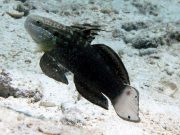
Amblygobius phalaena @ Koh Haa
The Banded Goby has several colour variations, ranging from a pale grey to dark brown body.
There are dark stripes on the head and forebody, and several darker bars toward the rear body. These stripes and bars may not be very clear on darker variations.
All variations have a black spot on the first dorsal fin. Most variations have a dusky spot on the upper tail, near the tail base, and a dark spot above the pectoral fin, close to the gill cover.
The Banded Goby grows to 13 cm, but usually observed around 10 cm or smaller, and can be found over sandy or rubble areas at the reef edge. This species feeds by gulping mouthfuls of sand from the seafloor and sifting out algae and invertebrates.
Blueband Goby
(Valenciennea strigata)
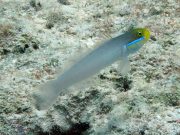
Valenciennea strigata @ Koh Haa
The Blueband Goby, or Bluestreak Goby has a white or grey body with a yellow face and snout. There is a bright blue stripe under the eye to the pectoral fin and several blue spots and markings on the head, gills and chin.
The Blueband Goby grows to 15 cm, but usually observed around 10 cm. This species is usually found in pairs over sand and rubble areas at the reef edge feeding by sifting mouthfuls of sand. The diet includes small invertebrates, fish, and fish eggs.
Steinitz' Shrimpgoby
(Amblyeleotris steinitzi)
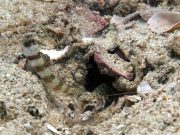
Amblyeleotris steinitzi @ Koh Haa
The Steinitz' Shrimpgoby has a white body with five vertical brown bars on the head and body. There are tiny yellow spots on both dorsal fins and on the upper body. There may be a very faint sixth bar, or blotch on the tail base. The iris is dark, or black.
Some variations of Steinitz' Shrimpgoby are very similar, but with much narrower body bars and a darker iris.

Steinitz' Shrimpgoby (Variation) @ Koh Haa
The Steinitz' Shrimpgoby grows to 8 cm and shares a burrow with one or more snapping shrimps of the genus Alpheus. These nearly-blind shrimp work tirelessly all day to excavate long burrows of up to one metre, and when above ground they always keep one antenna touching the goby tail to receive warnings of approaching danger.
The burrows run close to the surface and need to be continuously re-excavated due to collapse.
Barred Shrimpgoby
(Cryptocentrus fasciatus)
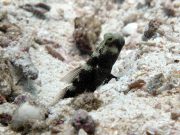
Cryptocentrus fasciatus @ Koh Haa
The Barred Shrimpgoby is variably coloured, and may have a pale body with four irregular brown bars, or a dark brown body with several whitish saddles on top of the head and along the back. Both variations have white or bluish streaks and spots on the head, forebody, pectoral and anal fins. The dorsal fin is unmarked.
The Barred Shrimpgoby grows to 8 cm and, similar to Steinitz' Shrimpgoby, shares a burrow with one or more snapping shrimps of the genus Alpheus.
The excavating shrimp create extensive burrows, with tunnels around 3 cm in diameter which connect 2 or 3 larger chambers within the network. Occasionally the goby will dart away from the burrow entrance to take a mouthful of sand which is sifted for food.
Twotone Dartfish
(Ptereleotris evides)

Ptereleotris evides @ Koh Haa
The Twotone Dartfish has a pale blue to greyish head and forebody, fading quickly to a very dark blue colouring on the rear body and second dorsal fin.
The tail is pale, forked and has dark margins. The gill covers may have small bright blue markings.
The Twotone Dartfish grows to 13 cm, but usually observed around 8 cm - 10 cm. This species lives in sandy burrows close to the reef edge and is almost always seen in pairs.
Spottail Dartfish
(Ptereleotris heteroptera)
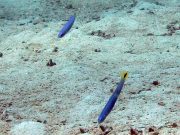
Ptereleotris heteroptera @ Koh Haa
The Spottail Dartfish has a long, thin, pale blue, or bluish grey body. The tail fin is yellow, with a large dark streak or spot in the middle.
The Spottail Dartfish lives over sand and rubble patches or hard substrates around the edges of a coral reef.
Adults are usually seen in pairs and share a burrow which is often under a rock or a piece of coral rubble. Occasionally several pairs are seen together.
Spottail Dartfish feed in pairs on zooplankton up to several meters above their burrow.
Blotched Goby
(Fusigobius inframaculatus)

Fusigobius inframaculatus @ Koh Haa
The Blotched Goby has a translucent body with many small orange spots on both the body and fins.
There are 4 - 5 large internal blackish blotches. The tail base has a white dash, followed by a black spot.
The first two dorsal spines are elongate and filamentous, especially in males, and less so in females.
The Blotched Goby grows to 7.5 cm and can be found over sand and coral rubble areas, though is rarely seen at the dive sites around Koh Lanta.
Signalfin Goby
(Fusigobius signipinnis)
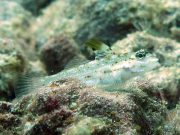
Fusigobius signipinnis @ Koh Haa
The Signalfin Goby has a translucent body covered with small brownish spots, white spots and dashes.
There is a red-brown to dark marking on the first dorsal fin, the 'signal'. The male has a taller, more heavily pigmented front dorsal fin.
The Signalfin Goby grows to 3 cm and is found over sand and rubble areas.
Yellowstripe Goby
(Koumansetta hectori)

Koumansetta hectori @ Koh Haa
The Yellowstripe Goby has a dark brown body with 4 bright yellow stripes.
There is a dark spot on the first dorsal fin, and a yellow edged black spot on the second dorsal fin and black spot on the upper tail.
The Yellowstripe Goby grows to 5 cm and is seen hovering over both live coral and coral rubble areas close to the reef.
Striped Dwarfgoby
(Eviota sebreei)
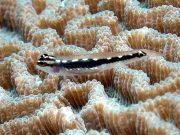
Eviota sebreei @ Koh Haa
The Striped Dwarfgoby has a translucent body and a prominent black internal stripe extending from the snout to tail fin base.
There are 8 small white blotches on the top of the dark internal stripe and the iris has a white stripe through its upper half.
The Striped Dwarfgoby grows to 25 mm (2.5 cm) and is often seen resting on live coral, sometimes in small groups.
Dykning med Kutmudingar runt Koh Lanta
Dykning och Snorkelutflykter
Om du vill ha en chans att se Kutmudingar på en av våra dagliga högsäsongs dykresor från Koh Lanta, skicka oss ett e-postmeddelande till info@diveandrelax.com.
Följ med på våra dykresor med speedboat under högsäsong till några av Thailands bästa dykplatser och njut av små grupper, korta restider och fokus på personlig service, säkerhet och nöje.
Är du ännu inte certifierad dykare? Lär dig att dyka på Koh Lanta med den 3-dagars SSI Open Water Diver-kursen.
Boka online och spara 10 % på dykresor och dykkurser på Koh Lanta.
Ta Reda på Mer
Guider för Marina Djur och Växter i Indo-Stilla Havet
- Allen, G., Steene, R., Humann, P., DeLoach, N. (2003) Reef Fish Identification, Tropical Pacific. Jacksonville, FL., USA: New World Publications, Inc., ISBN 1-878348-36-1.
- Humann, P., DeLoach, N., (2010) Reef Creature Identification, Tropical Pacific. Jacksonville, FL., USA: New World Publications Inc., ISBN 978-1-878348-44-9
- Debelius, H. (2013) Indian Ocean Reef Guide. Frankfurt, Germany: IKAN - Unterwasserarchiv, ISBN 978-3-939767-52-7.
- Debelius, H. (2004) Nudibranchs and Sea Snails, Indo-Pacific Field Guide. Frankfurt, Germany: IKAN - Unterwasserarchiv, ISBN 3-925919-51-1
- Erhardt, H., Knop, D. (2015) Corals Indo-Pacific Field Guide. Frankfurt, Germany: IKAN - Unterwasserarchiv, ISBN 3-925919-69-4.
- Veron J.E.N., Stafford-Smith M.G., Turak E. and DeVantier L.M. (2016). Corals of the World
